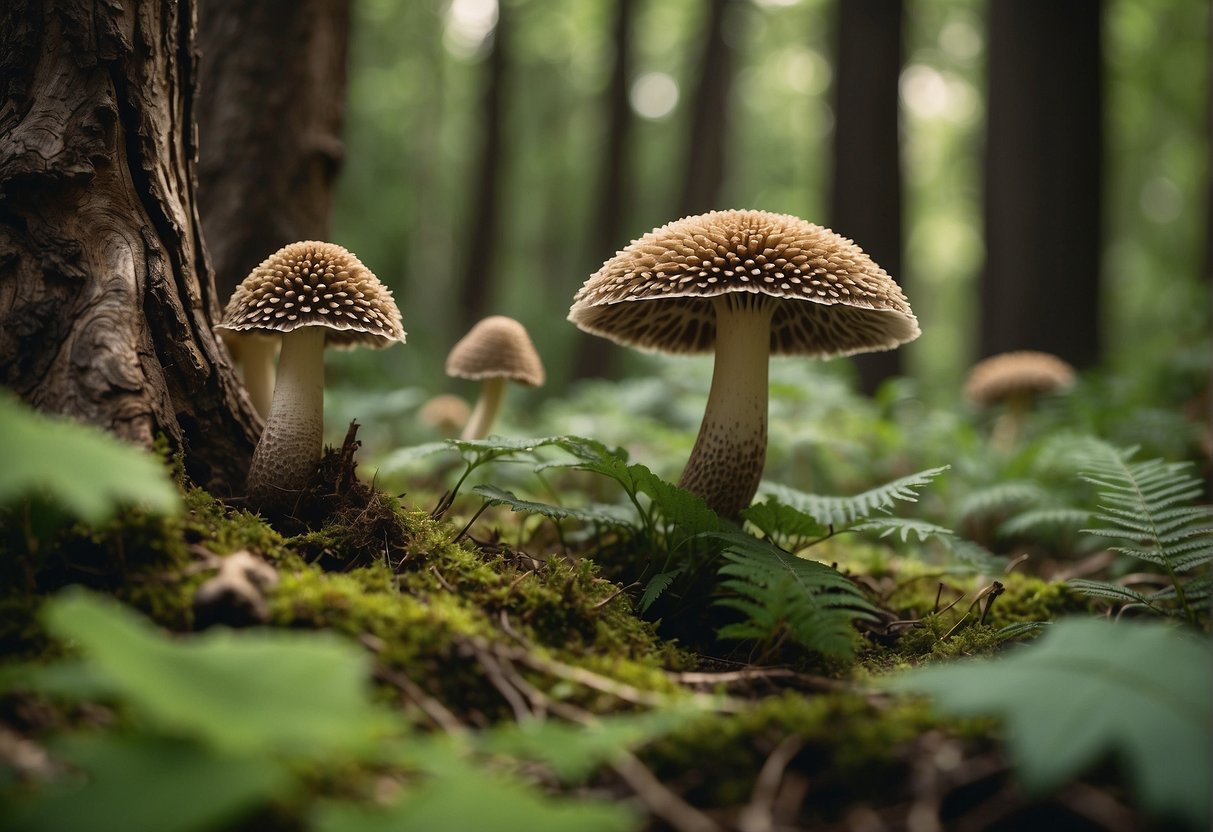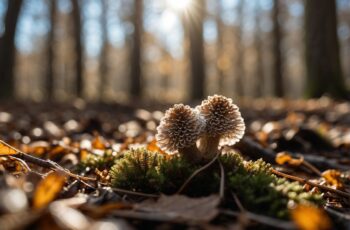When spring ushers in warmer temperatures and moist soil conditions, morel mushrooms start to become the prized find for foragers like you. These elusive fungi are known for their unique honeycomb appearance and rich, nutty flavor. As you make your way through the woods, understanding the symbiotic relationship morels have with certain trees can vastly improve your chances of a successful hunt.
Morels are selective about their habitat, often found in wooded areas with specific trees that help provide the necessary nutrients for growth. Identifying the right trees can lead you to the right spots; elm, ash, apple, and tulip poplar trees are commonly mentioned in discussions about morel-rich environments. The presence of these trees can indicate a hospitable environment for morels to thrive, given they often share the same needs for soil composition and sunlight exposure.
As a knowledgeable outdoorsman, you know that the condition of these trees can also be a telltale sign. Morels tend to favor the soil around aging or dying trees, especially elms afflicted by Dutch Elm Disease. But don’t just focus on the trees—pay attention to the soil. It should be well-draining and rich with organic matter, creating an ideal setting for these mushrooms to emerge and offer you the rewards of your foraging expertise.
Understanding Morel Mushrooms
As you set out into the woodland, knowing these key aspects of morel mushrooms will enhance your foraging experience. From their distinct appearance to their unique lifecycles and varieties, there’s much to appreciate about these savory fungi.
Characteristics of Morels
Morels are easily recognized by their honeycomb-like caps, which are attached to pale stems. Morchella elata and Morchella esculenta are two of the most common morel species you might encounter. Their caps are pitted and ridged, resembling a sponge, which helps distinguish them from potentially toxic look-alikes, like Gyromitra species, also known as false morels. Morels vary in color, ranging from pale cream to dark brown, vital clues to differentiate among the edible delights of the forest.
Lifecycle and Reproduction
Understanding the lifecycle and reproduction of morel mushrooms helps in identifying the prime time for foraging. Morels belong to the kingdom Fungus, and their life begins from spores, which germinate to form a network of mycelium under the forest floor. They thrive in a symbiotic relationship with trees. The mycelium absorbs nutrients from decomposing matter and can lie dormant until conditions are right for fruiting bodies to emerge.
Morel Species Varieties
Morel mushrooms boast several species, but three are primarily sought after for their culinary value:
- Morchella elata: Generally darker with a conical shape.
- Morchella esculenta (commonly known as the Yellow Morel): Lighter, with a rounder, wider cap.
- M. americana: Similar in appearance to esculenta but distinct genetically.
Each of these morels has its own preferred habitat and season, so get familiar with the trees and conditions that favor your local varieties for a successful forage.
Ideal Habitats for Morel Growth
When you’re on the hunt for morel mushrooms, knowing where to look is half the battle. The elusive morel favors specific conditions that must be considered to successfully locate these gourmet treasures.
Tree Associations
Morels have a fondness for certain trees. Specifically, they thrive in hardwood forests near elm, ash, apple, and dead or dying trees. Old apple orchards are often prime spots due to the abundance of organic matter. A mycorrhizal relationship between morels and trees, especially with elms and ash trees, is key to their growth. This symbiotic partnership allows morels to absorb water and nutrients from the tree roots and, in turn, help the tree absorb minerals.
- Elm Trees: Particularly those that have died the previous year.
- Ash Trees: Given an increase in ash borer infestations, morels may be found near affected trees.
- Apple Trees: Look for morels in old apple orchards, but be aware of pesticide use in commercial settings.
- Poplar, Sycamore, and Cottonwood Trees: These also provide a suitable environment for morels.
Soil and Climate Requirements
Morels are particular about their soil and climate conditions. Ideal habitats will have moist, well-drained soil rich in organic matter. The weather plays a significant role, with spring rains triggering morel emergence. You’ll generally find them when soil temperatures reach around 45-50 degrees Fahrenheit.
Preferred Conditions:
- Soil pH: Slightly alkaline to neutral.
- Climate: Warm days and cool nights in spring.
Effects of Disturbances
Disturbances in an ecosystem, such as wildfires, can create ideal habitats for morels. After a fire, nutrient-rich ash promotes prolific morel growth. Similarly, areas that have been logged or subjected to natural disturbances can also be hotspots, as the newly exposed soil and dead organic matter provide the perfect conditions.
- Fire Sites: Abundant the first few years post-burn.
- Flood Plains: Alongside rivers with cottonwood trees.
Foraging for Morel Mushrooms
Morel mushroom foraging blends the thrill of the hunt with the satisfaction of gourmet foraging. To ensure success, understanding the intricacies of morel ecology and adopting ethical foraging practices is essential.
Best Practices for Morel Hunting
When you embark on your hunt for morels, it’s crucial to be systematic. Morels tend to grow in conducive soils with the right light and temperature conditions, frequently found in the shade and areas with adequate water and rainfall. Begin your search in early spring, as morel season typically aligns with soil temperatures reaching about 50 degrees Fahrenheit. In the northeast and southeast states, as well as the Pacific Northwest, search around elm, ash, and apple trees, and in Pennsylvania, look for poplar trees. Remember that after forest fires, morels can often be found in burned areas, thriving on the nutrients released by the burn.
- Early Season (March-April): Look for black morels in wooded and burned areas.
- Mid-Season (May): Yellow morels begin to appear, keep an eye on moist and shaded areas.
- Late Season (June): The coveted ‘big yellows’ can be found.
Identifying Prime Foraging Seasons
To maximize your harvest, you must be attuned to regional morel seasons which can vary greatly by state. Early season typically sees the emergence of black morels, while late spring heralds the arrival of yellow morels. Pay attention to the soil temperature; once it stabilizes around 50 degrees after the last frost, it’s go-time for morel foraging. In several areas, especially the Pacific Northwest and certain eastern states, morel season corresponds to April through June.
Safety and Ethical Considerations
Your safety and respecting nature should be at the forefront while foraging. Always ensure to:
- Have the necessary knowledge to distinguish true morels from toxic varieties like the false morel.
- Cultivate an awareness of local wildlife and potential hazards.
- Carry the right equipment (basket, knife, whistles, map, and compass).
- Be mindful about not using pesticides or other harmful chemicals which can contaminate the foraging area.
Ethically forage by being mindful of the symbiotic relationship morels have with their environment. Harvest sensibly, leaving enough mushrooms to propagate for the next season, and don’t disturb the habitat you are foraging in.
Conservation and Sustainability

Morel mushrooms are an integral part of forest ecosystems, engaging in symbiotic relationships with certain trees that are vital for both entities’ survival. Their mycorrhizal connections help maintain ecological balance, but this balance is sensitive to human activities.
Human Impact on Morel Ecosystems
Human impact on morel ecosystems is significant and multifaceted. Overharvesting can deplete local populations, and the spread of diseases like Dutch elm disease has devastated populations of elm trees, which are critical to morel growth. The loss of these and other host trees, like aspen and sycamores, disrupts the delicate symbiotic relationship morels have with the undergrowth of forests. In addition, degradation of morel habitats due to logging or urban expansion can lead to decreased morel populations. Your awareness and actions directly influence the health of these ecosystems.
Promoting Sustainable Foraging Practices
Sustainable foraging practices help protect the future of morel species and their habitats. When searching for morels, focus on forests with a variety of potential host trees, such as walnut trees, tulip poplars, and aspen trees, all of which morels favor. It’s important to:
- Harvest responsibly: Take only what you need and leave enough morels for spore dispersal to ensure future growth.
- Mind the habitat: Avoid trampling the underbrush and soil around host trees to preserve the integrity of the mycorrhizal networks.
Foraging in regions like the northern hemisphere, where the relationship between morels and conifers or tulip poplar trees plays a crucial role in the local ecosystem, requires an environmental consciousness. By adopting and encouraging ethical foraging, you contribute to the conservation and health of forest ecosystems.


